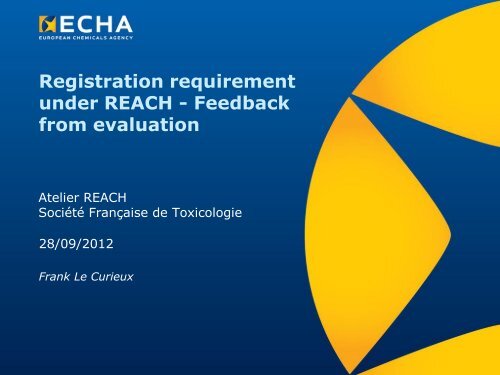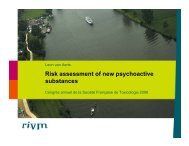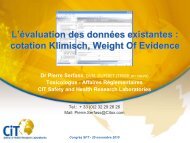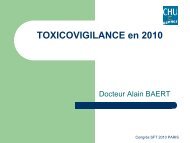Identify information requirements - SFT
Identify information requirements - SFT
Identify information requirements - SFT
You also want an ePaper? Increase the reach of your titles
YUMPU automatically turns print PDFs into web optimized ePapers that Google loves.
Registration requirement<br />
under REACH - Feedback<br />
from evaluation<br />
Atelier REACH<br />
Société Française de Toxicologie<br />
28/09/2012<br />
Frank Le Curieux
Overview<br />
• <strong>Identify</strong> the <strong>information</strong> <strong>requirements</strong><br />
• Meet the <strong>information</strong> <strong>requirements</strong><br />
• Testing proposals<br />
• Adaptations
<strong>Identify</strong> the <strong>information</strong> <strong>requirements</strong><br />
Atelier REACH - Société Française de Toxicologie 3
<strong>Identify</strong> <strong>information</strong> <strong>requirements</strong><br />
• Annex VI<br />
• Substance identity!<br />
• Depending on tonnage, <strong>requirements</strong> in Annexes<br />
VII-X<br />
Note exceptions, e.g.:<br />
• On-site isolated intermediates - Articles 17 + 49<br />
• Transported isolated intermediates - Article 18<br />
• Prior registration under NONS - Article 24<br />
Atelier REACH - Société Française de Toxicologie 28.09.2012<br />
4
<strong>Identify</strong> <strong>information</strong> <strong>requirements</strong> (2)<br />
• Carefully consider Annex column 1 and 2<br />
<strong>requirements</strong><br />
• e.g. Annex IX, 9.2.1 - biotic degradation<br />
• The column 1 requirement is dependent upon whether the substance is readily<br />
biodegradable (column 2). Carefully document the rationale.<br />
• Note interactions between Annexes<br />
• An adaptation may be available, depending on the results from<br />
other studies.<br />
• e.g. Annex VIII, 8.6.1. According to column 2, the 28-day study<br />
does not need to be performed if a reliable sub-chronic (90 days)<br />
or chronic toxicity study is available.<br />
Atelier REACH - Société Française de Toxicologie 28.09.2012<br />
5
Meet the <strong>information</strong> <strong>requirements</strong><br />
Atelier REACH - Société Française de Toxicologie 6
Step 1: Gather existing <strong>information</strong><br />
• Collect all relevant available <strong>information</strong> on the<br />
substance:<br />
• physical-chemical properties,<br />
• environmental toxicity and fate,<br />
• mammalian toxicity,<br />
• consider alternative <strong>information</strong> sources: in vitro, QSARs, read-across, etc.<br />
• Manufacture and use<br />
• Risk management measures<br />
• Exposure<br />
• Harmonised Classification and Labelling<br />
• Available <strong>information</strong> from assessments carried out under other<br />
international and national programmes<br />
Atelier REACH - Société Française de Toxicologie 28.09.2012<br />
7
Step 1: Gather existing <strong>information</strong> (2)<br />
• Evaluate the quality of data:<br />
• Is the data adequate for classification and labeling (C&L)?<br />
• … for persistent, bioaccumulative and toxic (PBT) assessment?<br />
• … for very persistent and very bioaccumulative (vPvB) assessment?<br />
• … for risk assessment?<br />
• Is the data reliable?<br />
• Is the data relevant?<br />
Atelier REACH - Société Française de Toxicologie 28.09.2012<br />
8
Step 2: Information <strong>requirements</strong><br />
• Comply with Annex VI <strong>requirements</strong>, including<br />
substance identity<br />
• Comply with tonnage band <strong>requirements</strong> (Annexes<br />
VII-X)<br />
• Provide all available and relevant data irrespective of<br />
tonnage<br />
• Consider potential options for adaptation found in:<br />
• Column 2 of Annexes VII-X<br />
• Annex XI<br />
Atelier REACH - Société Française de Toxicologie 28.09.2012<br />
9
Step 3: <strong>Identify</strong> <strong>information</strong> gaps<br />
• If available <strong>information</strong> is insufficient:<br />
1. Check if data holders within SIEF have the relevant data<br />
2. (optional) Check if data holders in other SIEFs (i.e. for other<br />
substances) have the relevant data<br />
3. Apply risk management measures<br />
• If sufficient <strong>information</strong> cannot be found, go to step 4.<br />
Atelier REACH - Société Française de Toxicologie 28.09.2012<br />
10
Step 4: Generate new <strong>information</strong><br />
•New data may be generated by alternative methodologies:<br />
• (Q)SARs<br />
• in vitro tests<br />
• weight of evidence, and<br />
• grouping approach<br />
•Animal tests should be done as a last resort<br />
•If adequate <strong>information</strong> is not available, then the test<br />
must be performed:<br />
• Generate new <strong>information</strong> (Annexes VII and VIII), or<br />
• Submit a testing proposal (Annexes IX and X)<br />
Atelier REACH - Société Française de Toxicologie 28.09.2012<br />
11
Testing proposals<br />
Atelier REACH - Société Française de Toxicologie 12
Testing proposals<br />
• Required for Annex IX and X tests<br />
• Must be flagged in IUCLID (and not just in<br />
Chemical Safety Report)<br />
• IUCLID - flag as testing proposal<br />
• “study result type”>> menu>> “experimental study planned”<br />
• Do not undertake testing while the TP is being<br />
evaluated<br />
Atelier REACH - Société Française de Toxicologie 28.09.2012<br />
13
Testing proposals (2)<br />
• Substance identity must be clearly addressed<br />
• Clearly identify test and provide all necessary<br />
<strong>information</strong><br />
• e.g. a pre-natal developmental toxicity test (OECD 414), in the<br />
rat by the oral route<br />
• Explain, and if necessary, justify<br />
• Why the test is necessary<br />
• e.g. it is an Annex IX requirement that must be fulfilled<br />
• concern for inhalation exposure in workers, hence do an inhalation study<br />
• Choice of test parameters<br />
• e.g. choice of test, choice of route of exposure, species etc.<br />
Atelier REACH - Société Française de Toxicologie 28.09.2012<br />
14
Adaptations<br />
Atelier REACH - Société Française de Toxicologie 15
Adaptation of standard info <strong>requirements</strong><br />
• Specific criteria in column 2 of Annexes VII-X<br />
• General criteria for adaptation in Annex XI:<br />
1. Testing not scientifically necessary<br />
2. Testing not technically possible: e.g. for volatile, reactive,<br />
unstable, explosive substances<br />
3. Substance-tailored exposure-driven testing<br />
• Necessary to directly address the legal <strong>requirements</strong><br />
and to explain and justify<br />
Atelier REACH - Société Française de Toxicologie 28.09.2012<br />
16
Adaptation - Annex XI, 1<br />
• XI, 1.1 Use of existing data<br />
• e.g. non-GLP data, historical human data<br />
• XI, 1.2 Weight of evidence<br />
• XI, 1.3 (Q)SARs<br />
• XI, 1.4 In vitro methods<br />
• XI, 1.5 Grouping/read-across<br />
• Necessary to provide “adequate and reliable documentation”<br />
to justify use of adaptation<br />
• Note the relevant guidance documents and practical guides<br />
• Practical guide on avoiding unnecessary testing:<br />
• http://echa.europa.eu/documents/10162/17250/pg_avoid_animal_testing_en.pdf<br />
Atelier REACH - Société Française de Toxicologie 28.09.2012<br />
17
An example:<br />
Annex XI, 1.5; grouping and read-across<br />
• Note <strong>requirements</strong> of legal text, especially for “adequate and<br />
reliable documentation”<br />
• Standard for documentation is set out in the guidance<br />
• http://echa.europa.eu/documents/10162/17224/<strong>information</strong>_<strong>requirements</strong>_r6_en.pdf<br />
• Need to explain (provide a hypothesis) why, for a given<br />
endpoint the properties of the registered substance “may be<br />
predicted from data for reference substance(s) within the<br />
group by interpolation to other substances in the group (readacross<br />
approach).”<br />
• Chemical similarity is not necessarily sufficient to justify a read-across<br />
• Practical guide on read-across:<br />
http://echa.europa.eu/documents/10162/17250/pg_report_readacross_en.pdf<br />
Atelier REACH - Société Française de Toxicologie 28.09.2012<br />
18
Annex XI, 3; Exposure-based adaptation<br />
• Only for endpoints in Annexes IX-X and<br />
• section 8.6 (repeated dose toxicity) and<br />
• Section 8.7 (reproductive toxicity) in Annex VIII<br />
• Needs exposure scenario(s) developed in the Chemical<br />
Safety Report<br />
• Documentation that the specific criteria are met<br />
Atelier REACH - Société Française de Toxicologie 28.09.2012<br />
19
Links<br />
• Webinar material<br />
• http://echa.europa.eu/en/web/guest/support/training-material/webinars<br />
• Guidance<br />
• http://echa.europa.eu/en/web/guest/support/guidance-on-reach-andclp-implementation<br />
• Guidance in a nutshell<br />
• http://echa.europa.eu/web/guest/support/guidance-on-reach-and-clpimplementation/guidance-in-a-nutshell<br />
• Practical guides available from:<br />
• http://echa.europa.eu/web/guest/support/<strong>information</strong>-toolkit<br />
• http://echa.europa.eu/web/guest/regulations/reach/evaluation<br />
• Evaluation Progress Reports<br />
• http://echa.europa.eu/web/guest/about-us/the-way-we-work/plans-and-reports<br />
Atelier REACH - Société Française de Toxicologie 28.09.2012<br />
20
Thank you<br />
http://echa.europa.eu/






